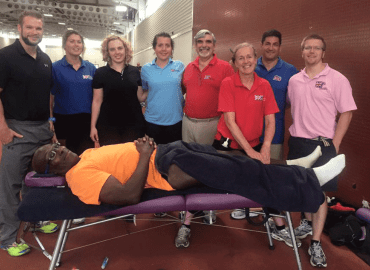The back is a complex structure of bone and muscle, supported by cartilage, tendons, and ligaments. It is estimated that 80% of the population will suffer from back pain at some point in their lives, of which lower back pain is the most common. A large percentage of lower back complaints are due to a lumbar (lower back) sprain or strain.
What is a Lumbar strain?
A strain is an injury to the muscles. A Lumbar Strain is an injury to muscles surrounding the lower back and pelvis, usually resulting in the muscles being over stretched and possibly torn.
What is a Lumbar sprain?
A sprain is the over ÔÇô stretching of a ligament.┬á A Lumbar Sprain is an injury to the ligaments that help support the lower back and pelvis, usually resulting in them being over stretched and possibly torn.
Sprains / strains can be graded in severity of 1, 2 or 3 starting with 1 being a simple over ÔÇô stretching of the soft tissue to 3 being severe tear or rupture of the soft tissue.
The lower back is normally exposed to increased stress and tension due to its  weight-bearing function and involvement in moving, twisting and bending. When the lumbar spine is strained or sprained, the soft tissues are over stretched and possibly torn leading to inflammation of the tissues. This inflammation results in pain and possible further muscle spasm and stiffness in the back, buttocks and legs.
Pain can be aggravated by bending, stretching, coughing, sneezing or other strenuous activities.
Causes of Lumbar Sprain/Strain
Low back strains/sprains can be caused by,
Direct Trauma
- Sports Injuries
- Falls
- Motor Vehicle Accident
- Poor Bending Technique
- Lifting Heavy Objects
- Postural Overuse, Fatigue and Repetitive Movement Trauma
- Intrinsic: Altered Biomechanics / Muscle Imbalances / Leg Length Inequality / Poor Core Stability / Overweight
- Extrinsic: Prolonged Sitting / Driving
- Sudden Unguarded Movement
Sign and Symptoms of Lumbar Sprain/Strain
The most common symptoms of a lumbar strain or sprain are,
- Pain around the low back and upper buttocks (sometimes posterior thigh and groin)
- Low back muscle spasm
- Stiffness and decreased mobility
- Pain on touch and possible local swelling
- Pain associated with activities, and generally relieved with rest
Treatment of Lumbar muscle strain and sprains
Initially: Apply Ice to the area to help control inflammation and decrease pain.  20 minutes on 1 hour off repeated 3-4 times over the next couple of days.
Full Chiropractic Assessment:
This will help determine the likely origin of you pain and discomfort. You will receive a full Orthopaedic, Neurological and biomechanics assessment. Depending on the findings you will likely receive a combination of the following:
- Chiropractic Adjustments to realign the spine and pelvis.
- Soft Tissue Techniques including Massage, Trigger Point Therapy, Active Release Techniques and Acupuncture to relax surrounding musculature, release tension, help realign pelvis and reduce pain and discomfort.
- Stretching Exercises for the muscles surrounding of the lower back and hip
- Core Stability and Corrective Exercises
- Mobility Exercises to help the function of the Lower Back and SI Joints.
- Lifestyle and Exercise Advice.
